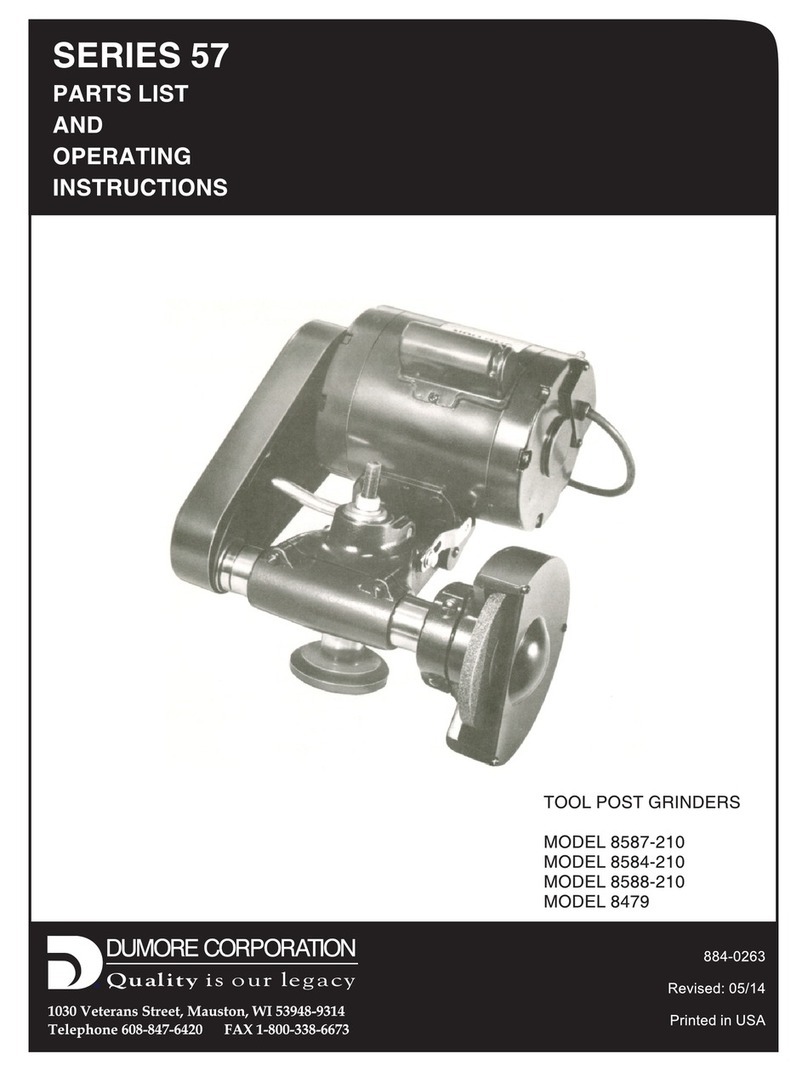
THE NEED FOR GROUNDING
In the event of a malfunction or breakdown, grounding provides
a path of least resistance for the electric current to reduce the
risk of electric shock. This tool is equipped with an electric cord
having an equipment grounding conductor and a grounding
plug. The plug must be plugged into a matching outlet that is
properly installed and grounded in accordance with all local
codes and ordinances.
s Note: Do not modify the plug provided - if it will not fit the
outlet, have the proper outlet installed by a qualified
electrician.
Improper connection of the equipment-grounding conductor
can result in a risk of electric shock. The conductor with
insulation having an outer surface that is green, with or without
yellow stripes, is the equipment - grounding conductor. If repair
or replacement of the electric cord or plug is necessary, do not
connect the equipment-grounding conductor to a live terminal.
Check with a qualified electrician or serviceman if the grounding
instructions are not completely understood, or if in doubt as to
whether the tool is properly grounded.
Repair or replace damaged or worn cord immediately.
Periodically check the ground circuit of the cord for continuity.
The use of a ground-fault protected receptacles is
recommended.
s WARNING: THIS TOOL SHOULD ONLY BE USED WHERE
POINT OF OPERATION GUARDING DEVICES HAVE BEEN
PROPERLY INSTALLED SO THAT IT IS IMPOSSIBLE FOR
THE OPERATOR’S HANDS OR FINGERS TO REMAIN
WITHIN THE POINT OF OPERATION DURING THE ACTUAL
MACHINE CYCLE.
s WARNING: Read all instructions. When using electric
tools, basic safety precautions should always be used to
reduce the risk of fire, electric shock, and personal injury,
including the following:
1. ALWAYS USE SAFETY GLASSES
(ANSI Z87.1 with side shields or an equivalent).
Polycarbonate lenses have been found to provide better
impact resistance than glass lenses
2. WEAR PROPER APPAREL
No loose clothing, gloves, neckties, rings, bracelets, or
other jewelry to get caught in moving parts. Non slip
footwear is recommended. Wear protective hair covering
to contain long hair.
3. DO NOT USE IN DANGEROUS ENVIRONMENT
Do not use power tools in damp or wet locations, or expose
them to rain. Keep work area well lighted. Do not use tool in
presence of flammable liquids or gases.
4. KEEP WORK AREA CLEAN
Cluttered areas and benches invite accidents.
5. DO NOT OVER-REACH
Keep proper footing and balance at all times.
6. REDUCE THE RISK OF UNINTENTIONAL
STARTING
Make sure switch is in off position before plugging.
7. CHECK DAMAGED PARTS
Check for alignment of moving parts, breakage of parts,
mounting, and any other conditions that affect its
operation. A part that is damaged should be properly
repaired or replaced by an authorized service center
unless otherwise indicated elsewhere in this instructional
manual. DO NOT USE TOOL IF SWITCH DOES NOT
TURN IT ON AND OFF. HAVE DEFECTIVE SWITCHES
REPLACED BY AUTHORIZED SERVICE CENTER.
8. DISCONNECT TOOLS
When not in use, before servicing and when changing
accessories, such as grinding wheels, etc.
9. REMOVE KEYS AND WRENCHES
Form habit of checking to see that keys and adjusting
wrenches are removed from tool before turning it on.
10. MAINTAIN TOOLS WITH CARE
Keep tools sharp and clean for best and safest
performance. Follow instructions for lubricating and
changing accessories. Inspect tool cords daily and if
damaged, have repaired by authorized service facility.
Inspect extension cords before use and replace if
damaged. Keep handles dry, clean, and free of oil and
grease.
s SAFETY INSTRUCTIONS
FUSE INTACT
HOT LINE
THIS SYSTEM IS DANGEROUS!
Don’t act as a conductor—Make
sure the tool is grounded through
the cord.
GROUNDING
BLADE COVER OF
GROUNDED
OUTLET BOX
GROUNDING MEANS
COVER OF
GROUNDED
OUTLET BOX
3




























